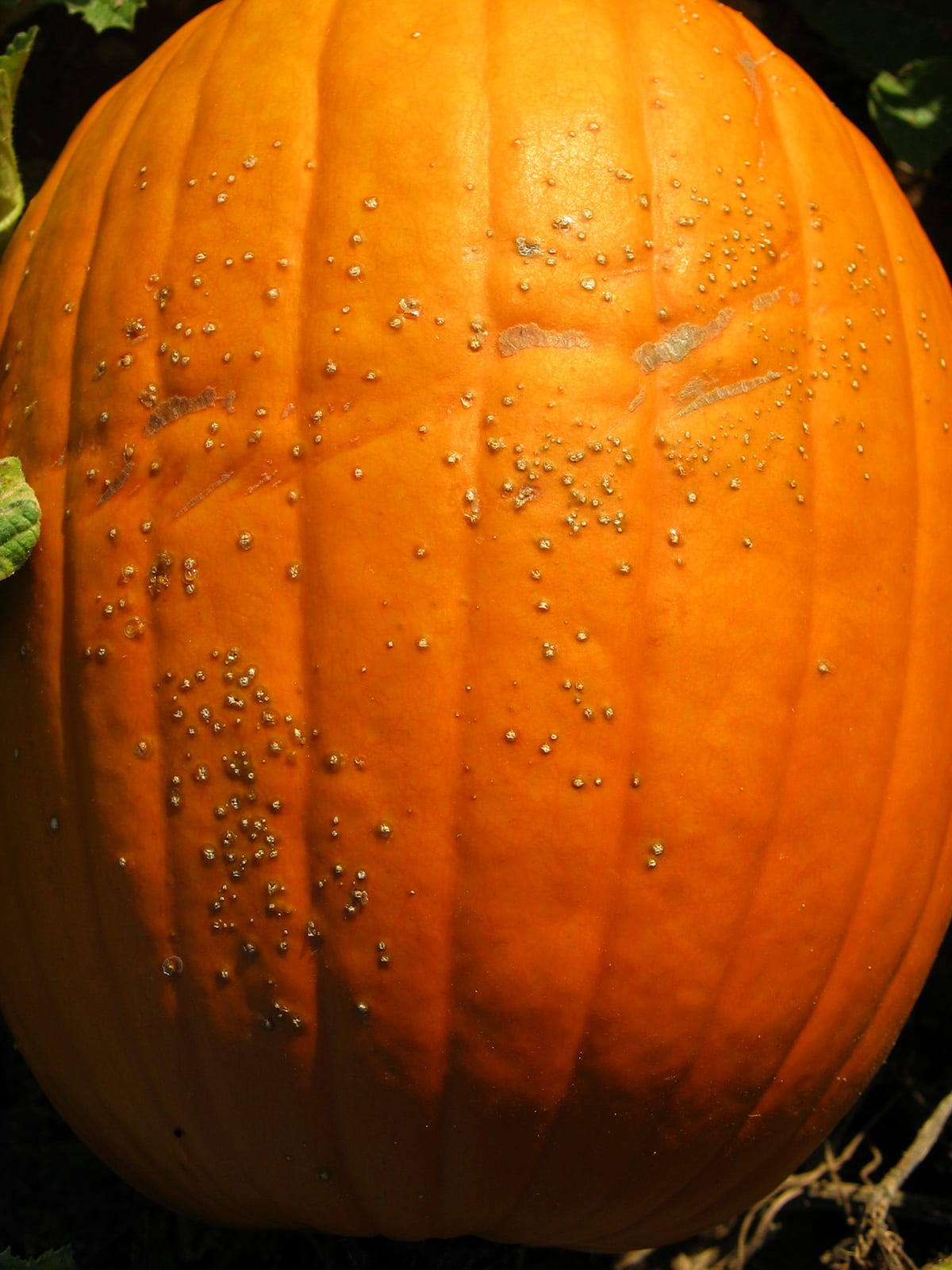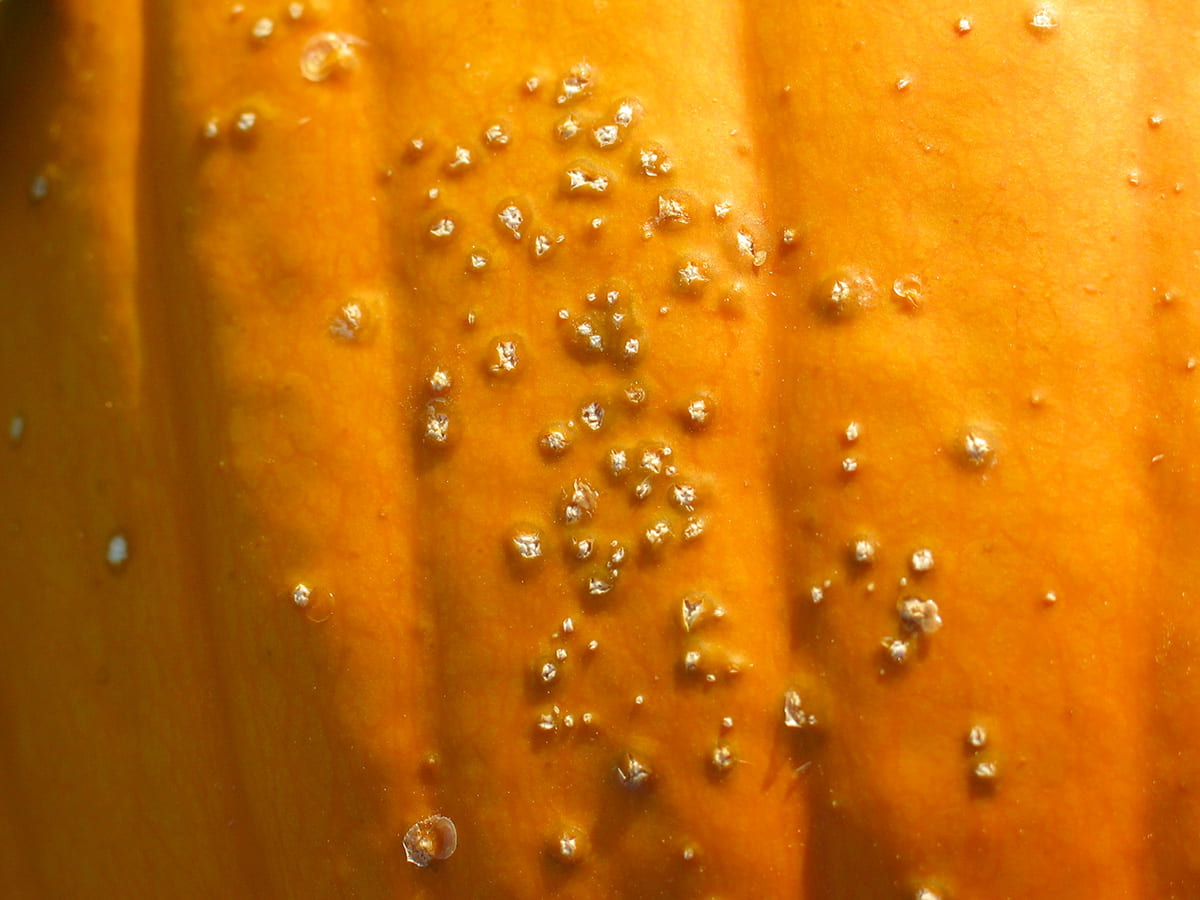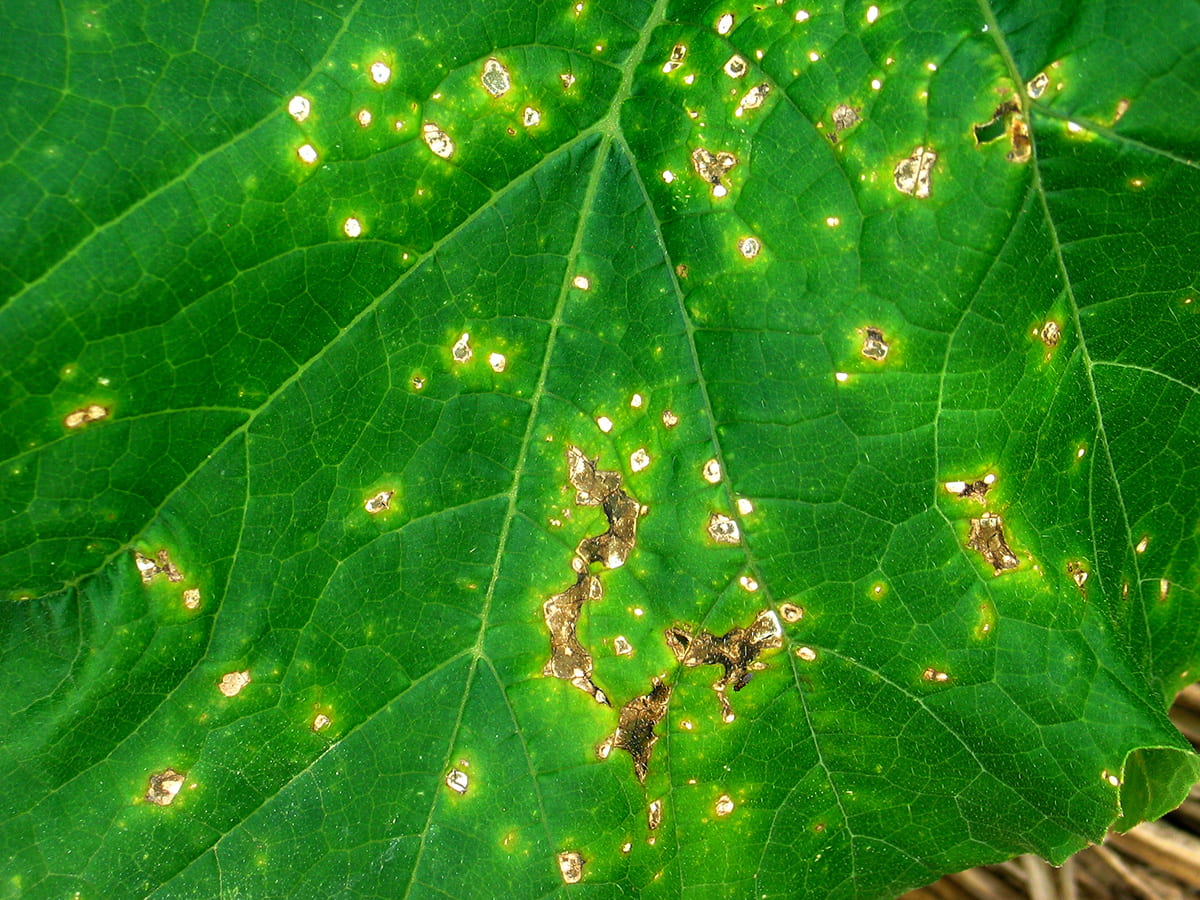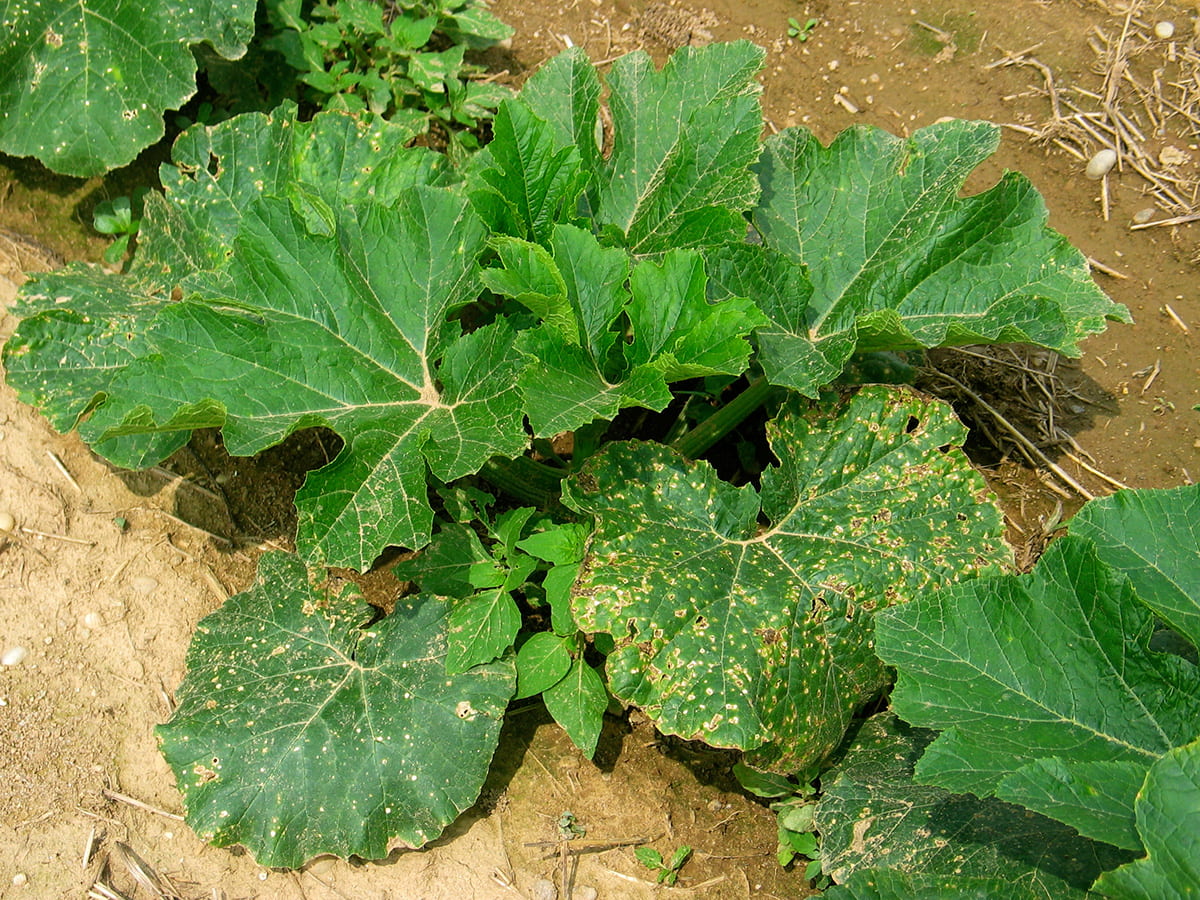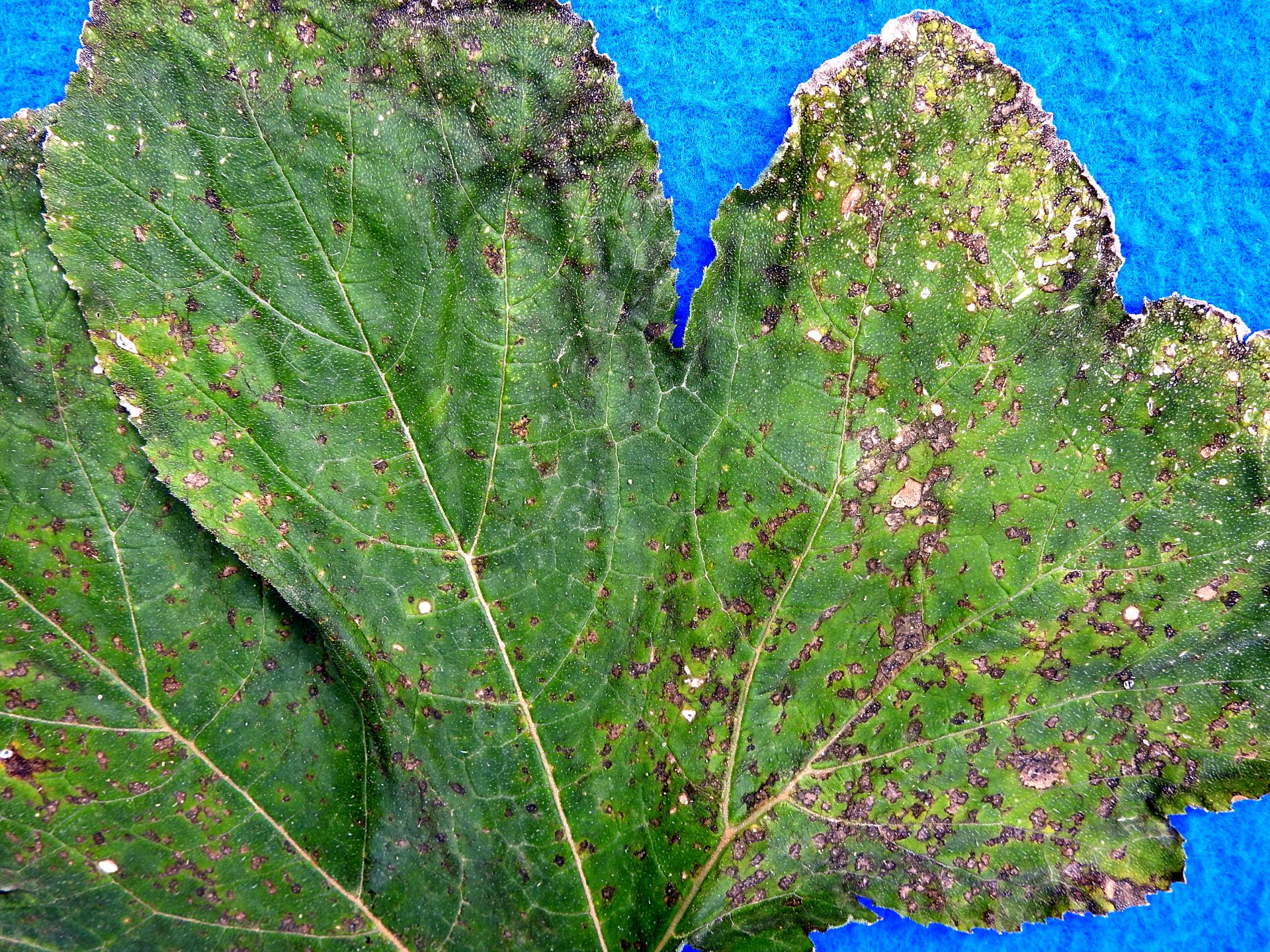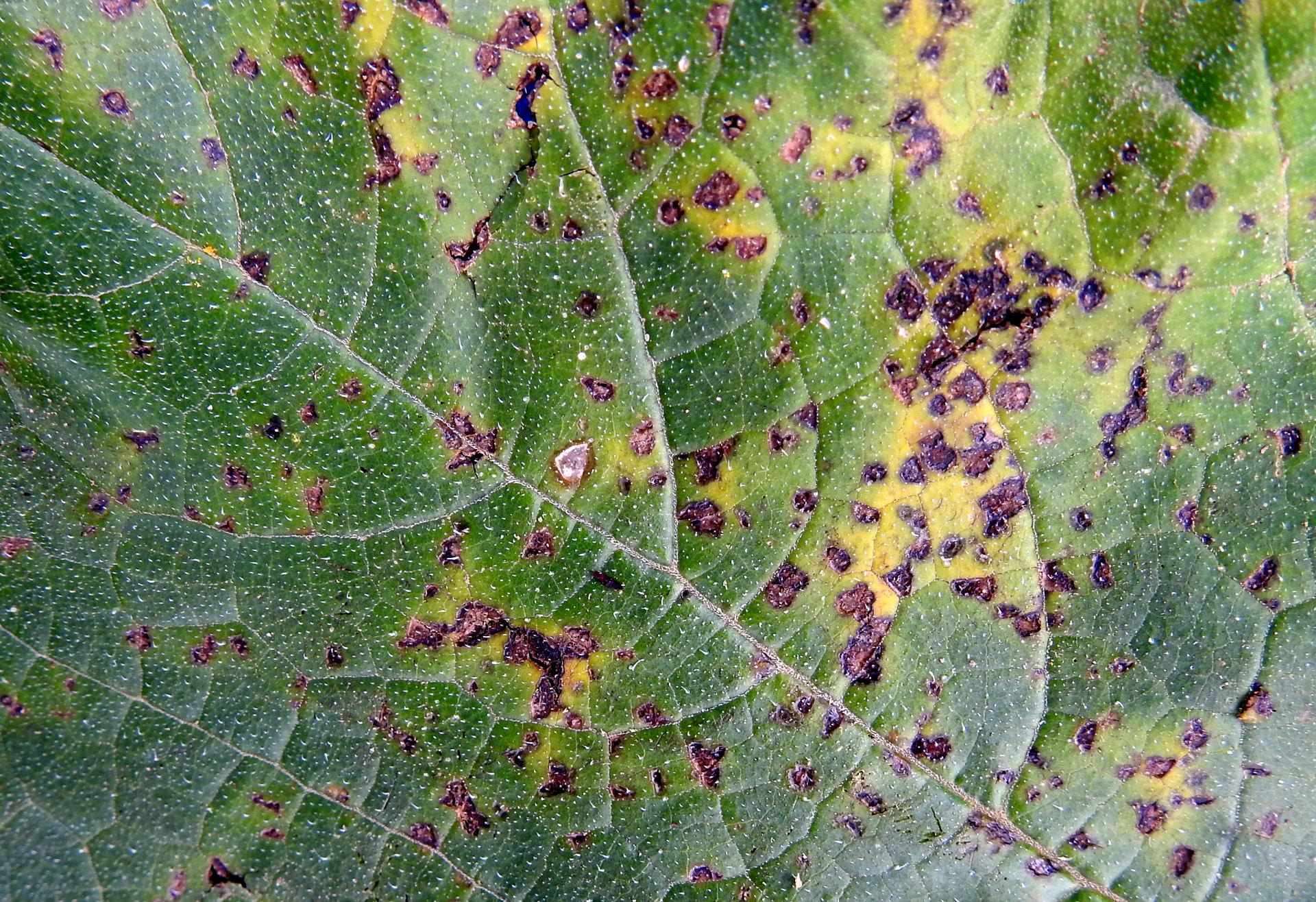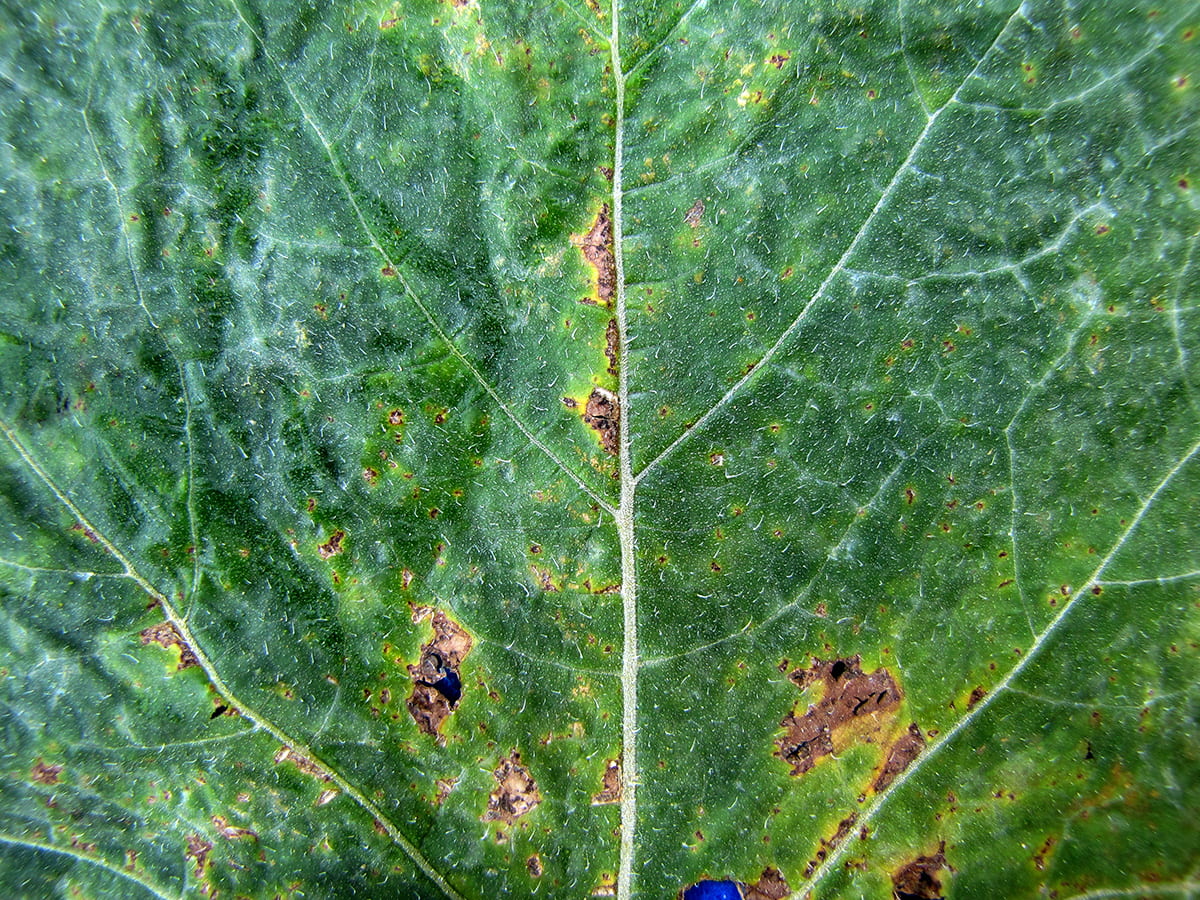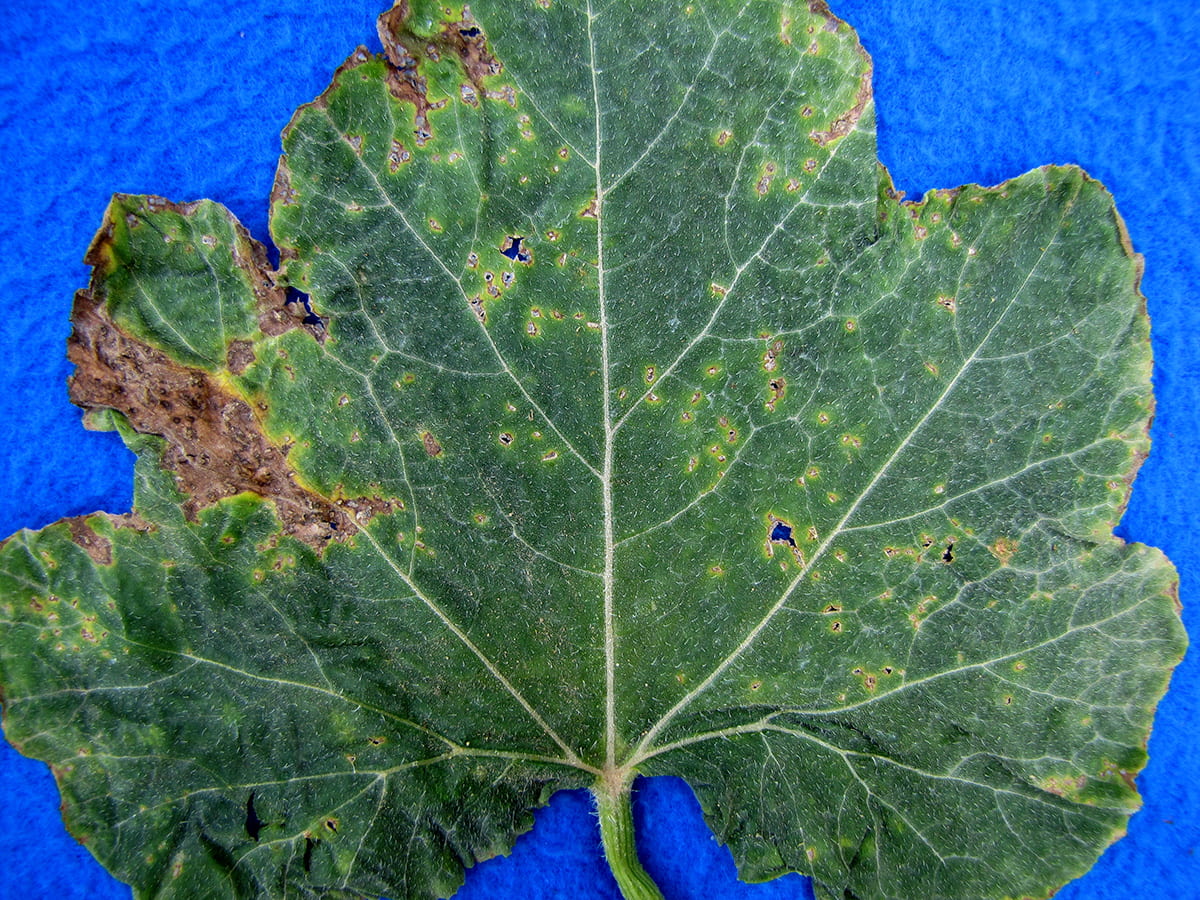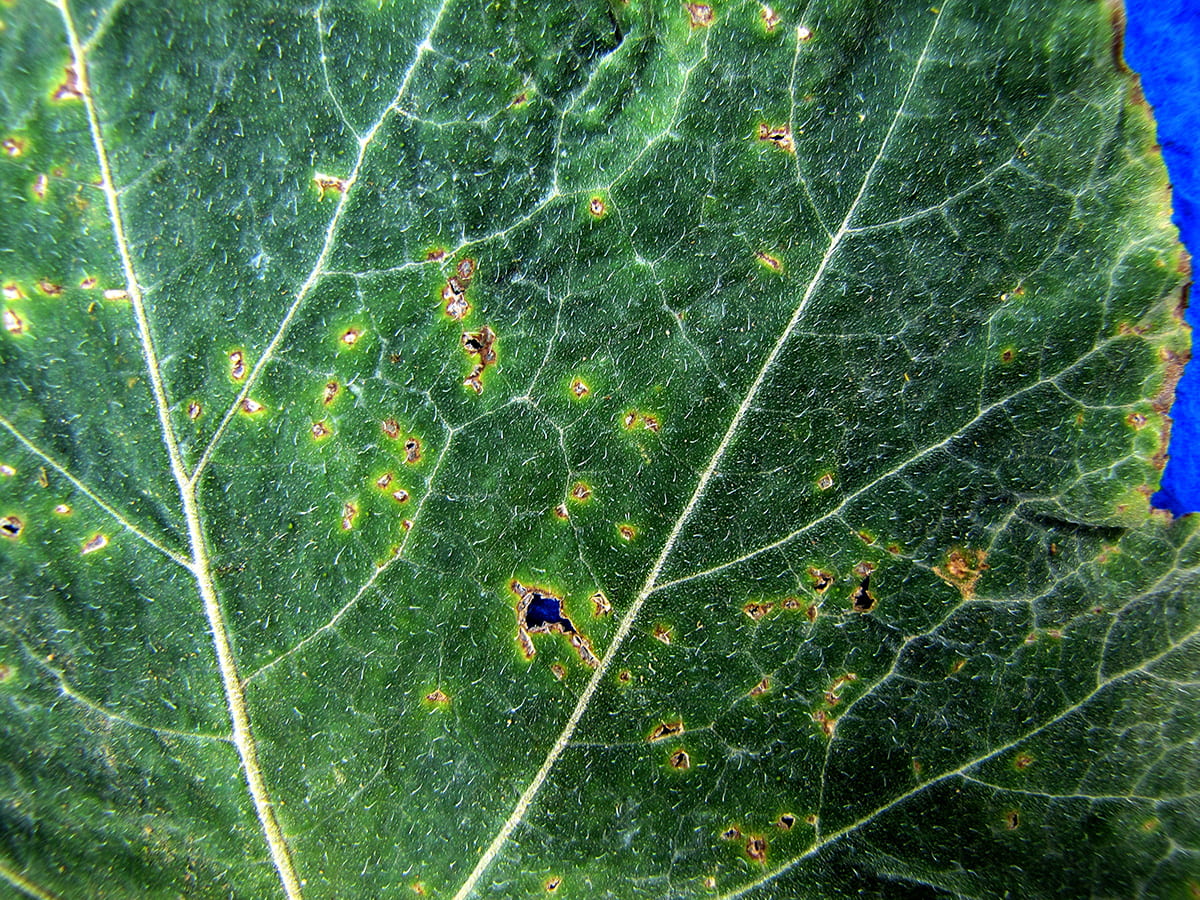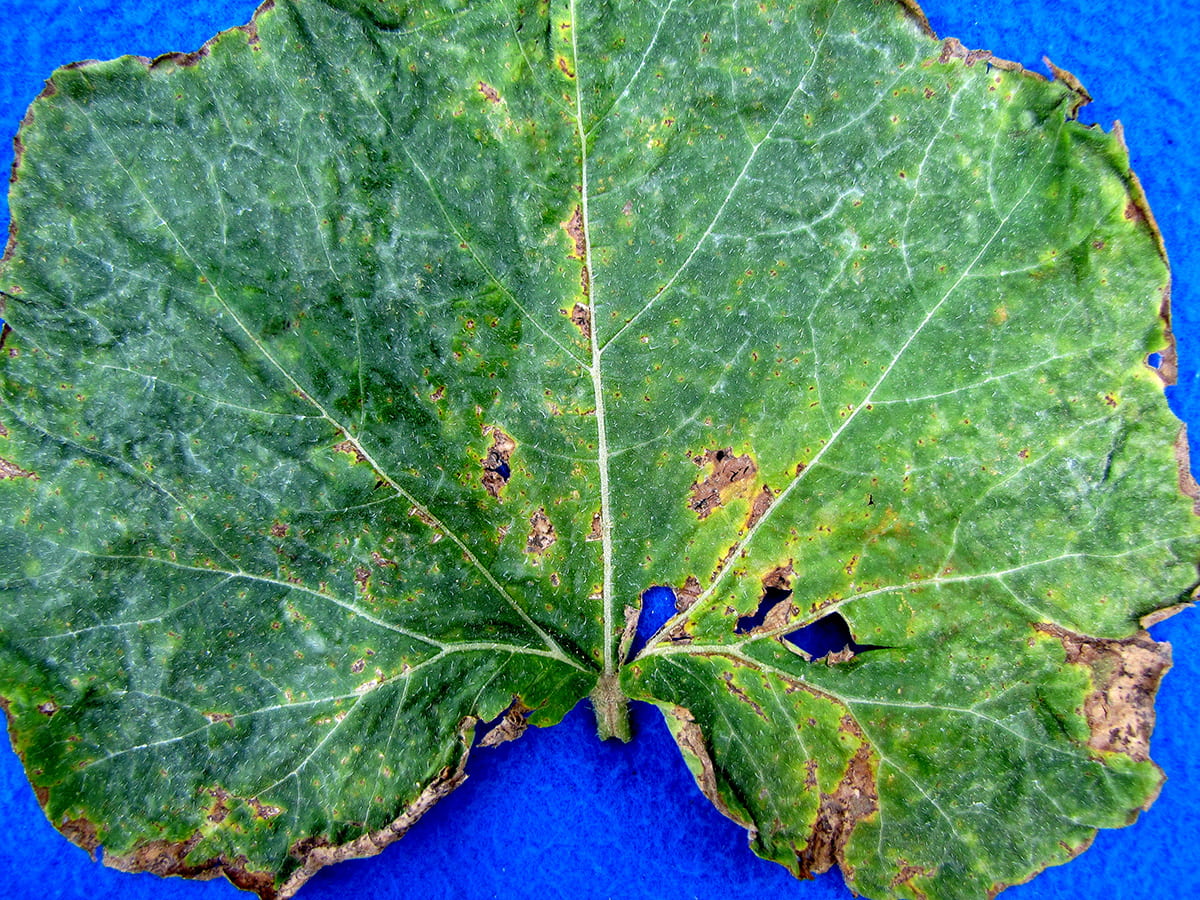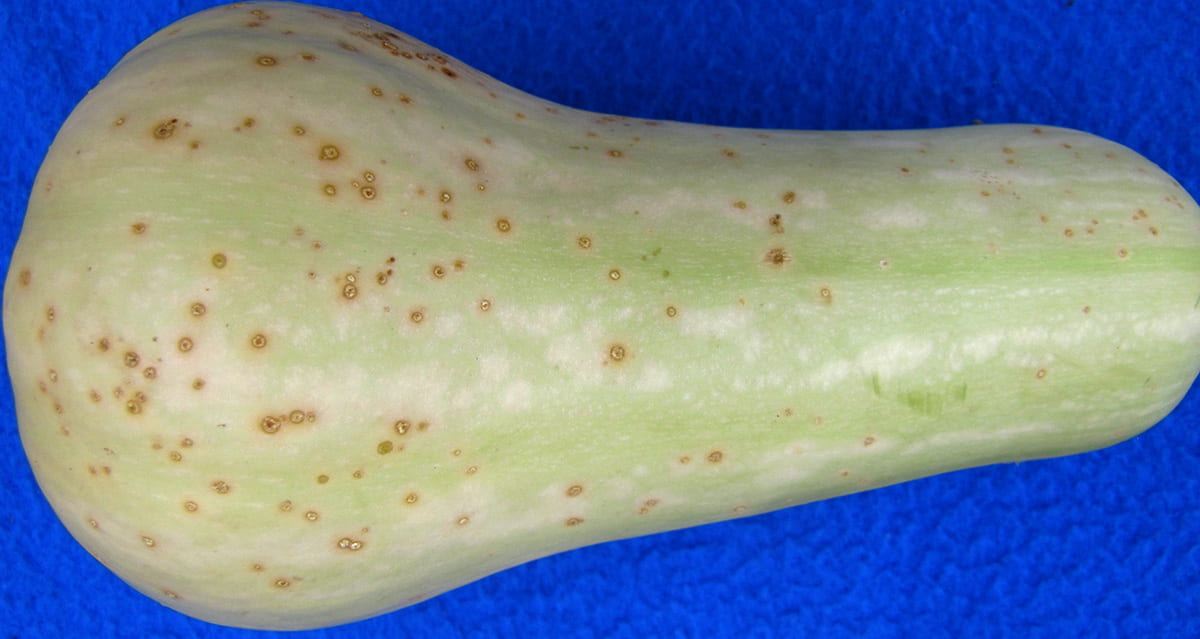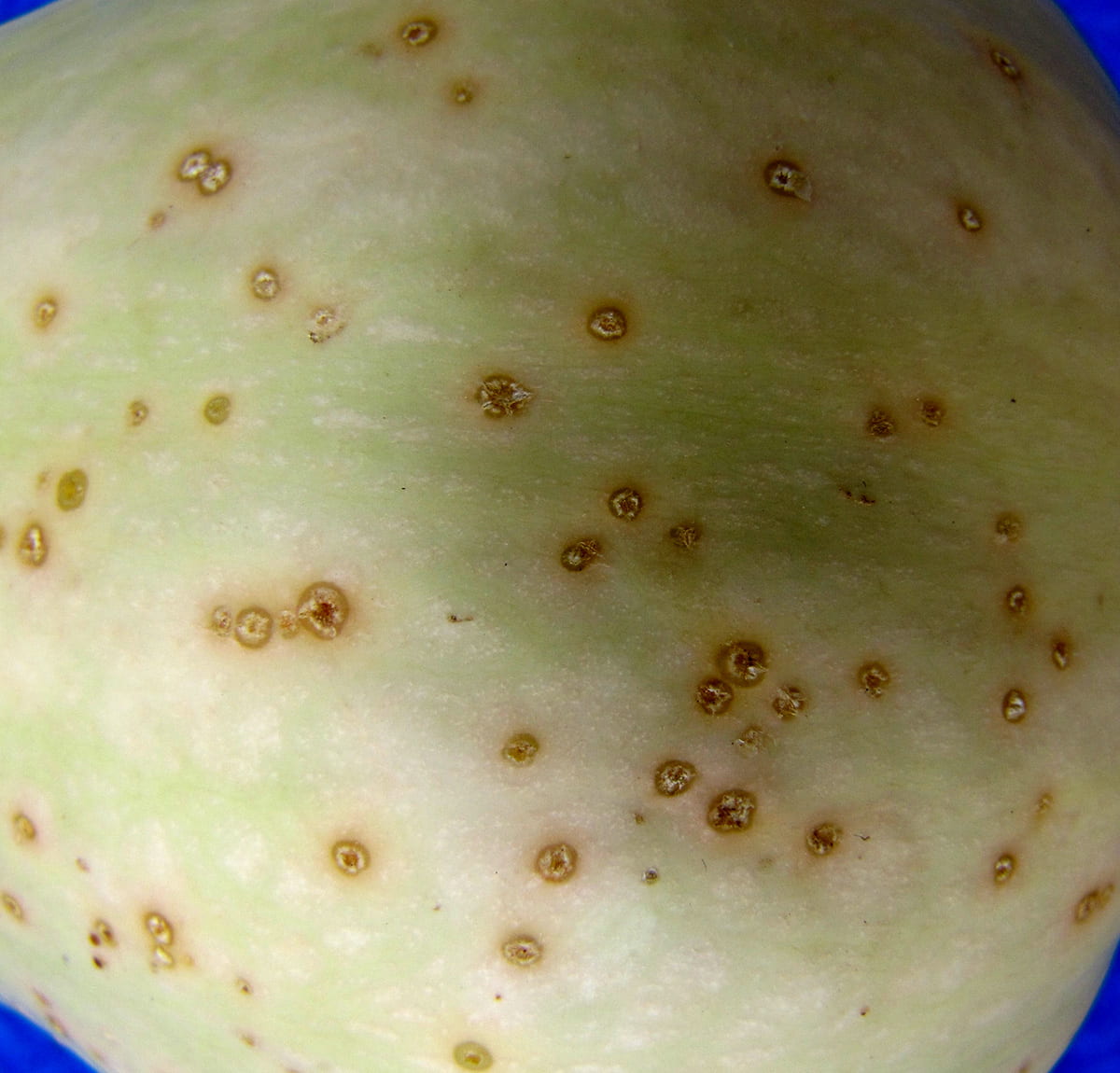This disease was previously known as Bacterial leaf spot.
All cucurbit crop types are susceptible, but XLS has mostly been occurring in pumpkin. It has been reported as increasing in importance in pumpkin in the Northeast and Midwest.
Symptoms are small, round to irregular shaped, black spots on leaves. Initially these spots are water-soaked. Often they develop a yellow border. Several spots coalesced together can cause that part of the leaf to be distorted. The center can become rotten as the spot ages. Symptoms are similar to those of angular leaf spot, another bacterial disease.
The pathogen can also infect fruit causing small, round, water-soaked spots that often have a white crusty center. These spots can form an entryway for soft rotting bacteria, which will cause the fruit to collapse.
There are no resistant pumpkin varieties, only cucumber, but variation in susceptibility has been detected among varieties. Solid Gold was affected less than Charmed in an experiment in Ohio (J. Jasinski; PDMR 6:V054).
Rain provides conditions for pathogen dispersal in splashing water and for infection (leaf wetness). Overhead irrigation can also spread the pathogen and create conditions favorable for development. Irrigate in the middle of the day after a good drying period so leaves are dry when irrigation is started. Having good conditions for drying leaves afterwards (sunny and windy) is also important. Best to use drip irrigation when feasible. XLS may appear to stop developing during a drought period in a drip irrigated crop.
Do not work in fields when leaves are wet because equipment and workers brushing against leaves that are infected can move bacteria to healthy leaves touched subsequently.
Check plants routinely for symptoms. Rogueing individual affected plants when detected early can be worthwhile.
Manage weeds. XLS pathogen can infect or survive epiphytically on some weeds.
Fungicides with activity against bacteria are recommended applied on a weekly, preventive schedule for most bacterial diseases. Copper combined with mancozeb has been the only fungicide option until recently. It has provided good control especially when started before symptoms start to develop, but copper is inherently not highly effective (compared to modern fungicides with targeted activity) and several bacterial pathogens have developed resistance to copper. Actigard is labeled for XLS and angular leaf spot. Biopesticides labeled for XLS include Brandt Organics Aleo, Cease, Regalia, and Serenade AOS. Other biopesticides labeled generally for managing bacterial diseases on cucurbits include GreenFurrow BacStop, KeyPlex 350, Thyme Guard, and Thymox Control. These biopesticides are all approved for organic production. Plant activators like Actigard and Regalia need to be applied starting before infection to be most effective. They are recommended used in a program with copper and/or other biopesticides that directly affect pathogens (alternation or tank mix). See section with results from fungicide evaluations below.
Destroy plant debris after harvest and rotate out of an affected field for at least 3 years. Through research conducted recently in Illinois (M. Babadoost et. al.), a 3-yr rotation was shown effective for delaying onset and reducing severity of XLS compared to a 2-yr rotation or continuous pumpkin production, but did not eliminate XLS. XLS pathogen was able to infect bur cucumber and velvetleaf, and was isolated from some symptom-less weeds. It was shown to remain viable for at least 2 years when associated with plant debris (leaves and fruit), but not to survive in soil long enough for soil to be a potential source of the pathogen.
Do not save seed from affected fruit as the pathogen can be seed-borne. The pathogen has not often been found in commercial seed lots, and when found it was at a low level. It was shown to survive about 2 years in seed (18 mo at 72 F and 28 mo at 39 F), but survival steadily declined over time. While not considered necessary, hot-water seed treatment for 15 min at 131 F was shown to be effective. (this information is from research conducted by M. Babadoost et. al. in Illinois)
Results of note from fungicide evaluations:
Value of a preventive spray program was documented through 2 experiments in Illinois in which fungicides applied starting a few days before inoculation were numerically albeit usually not significantly more effective than when delayed until a few days afterwards (M. Babadoost; PDMR 7:V117 and 8:V284). Note that all treatments were started before symptoms had developed from the inoculation. Many treatments were different copper formulations.
Symptoms on leaves sometimes have been managed more effectively than those on fruit, reflecting the difficulty of getting a fungicide application to penetrate the large-leaved pumpkin canopy to reach fruit below. All 5 copper fungicides in the 2 experiments described above had significantly less severe XLS symptoms on leaves compared to the untreated control; incidence and severity of fruit symptoms were reduced by all in 2013 but not in 2012 when only Badge X2 and Phyton-016B applied starting before inoculation were effective. All 11 treatments tested in Illinois in 2017 controlled symptoms on leaves, but only 1 had significantly fewer affected fruit than the control, however, all did have numerically fewer affected fruit (M. Babadoost; PDMR 12:V105). Kocide + Manzate provided 23% control of symptoms on leaves but did not significantly reduce fruit symptoms in an experiment in Ohio in 2014 (S.A. Miller; PDMR 9:V059). On the other hand, Kocide + Manzate alternated with Regalia provided 50% control of symptoms on foliage and reduced incidence of affected fruit by 74% in Illinois in 2019 (M. Babadoost; PDMR 14:V066).
Efficacy of Actigard and Regalia (both plant activators) have been documented. Regalia tested alone reduced severity of foliar symptoms and incidence of affected fruit (M. Babadoost; PDMR 8:V284). Actigard + Kocide-3000 was numerically but not significantly better than Kocide-3000 applied alone in this experiment while the combination usually was significantly better in 2013 (M. Babadoost; PDMR 7:V117). Actigard was providing 53% control of foliar symptoms on 19 Sep and 12% on 10 Oct 2020 in another experiment in Illinois, while a program starting with 2 or 4 applications of Actigard followed by Regalia alternated with Kocide + Manzate was providing 30% control on 10 Oct (M. Babadoost; PDMR 15:V084). LifeGard, an organic plant activator, was not as effective as Actigard on 19 Sep (31% control) but was on 10 Oct (17%). Actigard was more effective applied to moderately susceptible variety Solid Gold (74% control based on incidence of fruit with symptoms and 88% reduction in severity of fruit symptoms) than to Charmed (46 and 80% control), Kocide-3000 was only effective applied to Solid Gold (21 and 43%), while Serenade Max and OxiDate were not effective in an experiment in Ohio in 2011 (J. Jasinski; PDMR 6:V054).
Please Note: Fungicides mentioned are for use in commercial production, not gardens. The specific directions on pesticide labels must be adhered to — they supersede these recommendations if there is a conflict. Any reference to commercial products, trade or brand names, is for information only; no endorsement is intended. For up-to-date information on labeled conventional fungicides see Cornell Integrated Crop and Pest Management Guidelines for Commercial Vegetable Production and biopesticides see the Biopesticides website.
Symptoms on pumpkin fruit and leaves:
Symptoms on butternut squash leaf and fruit:
Symptoms on cucumber leaf (bacterial streaming was observed from removed leaf piece):



